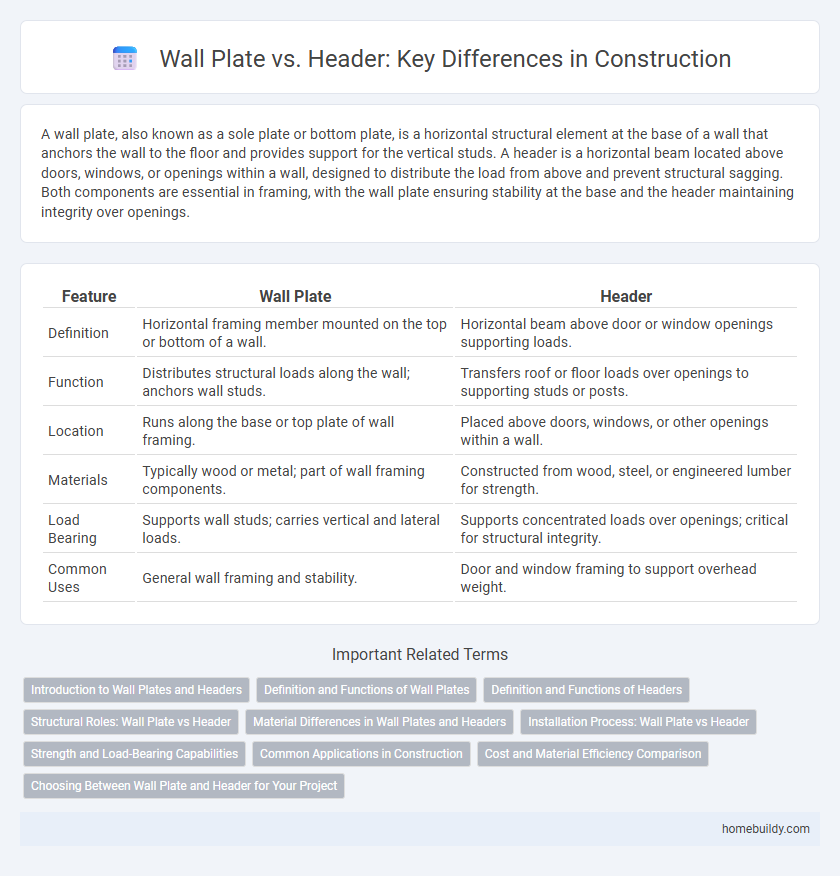A wall plate, also known as a sole plate or bottom plate, is a horizontal structural element at the base of a wall that anchors the wall to the floor and provides support for the vertical studs. A header is a horizontal beam located above doors, windows, or openings within a wall, designed to distribute the load from above and prevent structural sagging. Both components are essential in framing, with the wall plate ensuring stability at the base and the header maintaining integrity over openings.
Table of Comparison
| Feature | Wall Plate | Header |
|---|---|---|
| Definition | Horizontal framing member mounted on the top or bottom of a wall. | Horizontal beam above door or window openings supporting loads. |
| Function | Distributes structural loads along the wall; anchors wall studs. | Transfers roof or floor loads over openings to supporting studs or posts. |
| Location | Runs along the base or top plate of wall framing. | Placed above doors, windows, or other openings within a wall. |
| Materials | Typically wood or metal; part of wall framing components. | Constructed from wood, steel, or engineered lumber for strength. |
| Load Bearing | Supports wall studs; carries vertical and lateral loads. | Supports concentrated loads over openings; critical for structural integrity. |
| Common Uses | General wall framing and stability. | Door and window framing to support overhead weight. |
Introduction to Wall Plates and Headers
Wall plates and headers are crucial structural components in construction, each serving distinct functions in framing. Wall plates, typically horizontal timber or metal elements, distribute loads from the roof or floor to wall studs, ensuring stability and alignment. Headers, usually positioned above openings like doors and windows, support the weight above these gaps, preventing structural sagging or failure.
Definition and Functions of Wall Plates
Wall plates are horizontal structural elements that distribute loads from the roof or floor to the vertical studs in a wall frame, providing essential stability and support. Unlike headers, which are typically installed above openings such as doors and windows to carry concentrated loads, wall plates run continuously along the top or bottom of the wall to evenly transfer weight. Their primary function includes anchoring the wall studs and securing the frame to the foundation or upper structure, ensuring overall rigidity in building construction.
Definition and Functions of Headers
Headers are horizontal structural components placed above doors, windows, and openings in a wall to support the load from the wall or roof above. Unlike wall plates, which serve as base or top connectors for wall studs, headers distribute weight evenly to avoid structural damage and maintain stability. Their function is crucial in framing construction, ensuring openings do not compromise the integrity of the building.
Structural Roles: Wall Plate vs Header
Wall plates serve as crucial horizontal support elements that distribute loads from roof trusses or joists evenly onto studs, ensuring structural stability in framed walls. Headers function as reinforced beams positioned above openings such as doors and windows, bearing concentrated loads to prevent sagging and maintain the integrity of the wall structure. Both components work together to manage different load types, with wall plates transferring distributed loads and headers handling concentrated loads around openings.
Material Differences in Wall Plates and Headers
Wall plates are typically made from materials such as wood, metal, or plastic, chosen for durability and ease of installation around electrical fixtures or outlets. Headers, in contrast, are structural components often constructed from engineered wood, steel, or laminated veneer lumber to bear and distribute loads above openings like doors and windows. Understanding the material differences between wall plates and headers is crucial for ensuring both safety and functionality in construction projects.
Installation Process: Wall Plate vs Header
The installation process for a wall plate involves securely fastening it flat against the wall surface to support electrical outlets or switches, ensuring proper alignment and stable mounting. In contrast, installing a header requires positioning and anchoring a horizontal structural beam above doorways or windows to bear load distribution, often involving precise measurements and heavy-duty fasteners. While wall plate installation is straightforward and primarily electrical-focused, header installation demands structural expertise to maintain building integrity.
Strength and Load-Bearing Capabilities
Wall plates distribute vertical loads evenly across wall studs, enhancing structural integrity by providing a stable base for framing and supporting roof or floor loads. Headers, typically made from laminated beams or multiple dimensional lumber, are engineered to span large openings and bear concentrated loads from above, offering superior strength and load-bearing capacity compared to standard wall plates. In load-bearing applications, headers are critical for transferring heavy loads around doors or windows, while wall plates primarily serve as continuous support along walls.
Common Applications in Construction
Wall plates provide a stable base for securing wall studs and distributing loads evenly, commonly used in framing walls and supporting roof structures. Headers serve as horizontal beams above openings like doors and windows, bearing the load from above and transferring it to adjacent studs. Both are essential for structural integrity, with wall plates often found at floor and ceiling junctions, while headers reinforce openings in load-bearing walls.
Cost and Material Efficiency Comparison
Wall plates generally cost less and use less material than headers, making them a more economical choice for supporting wall structures. Headers typically require thicker or engineered lumber to carry heavier loads, increasing both material expense and installation time. Choosing wall plates over headers in non-load-bearing applications optimizes material efficiency and reduces overall construction costs.
Choosing Between Wall Plate and Header for Your Project
Selecting between a wall plate and a header depends on the structural requirements of your construction project. Wall plates serve as a base for securing studs or trusses, distributing loads evenly, while headers are specifically designed to support loads above openings like doors or windows. Understanding the load-bearing capacity and placement needs will ensure the right choice for stability and compliance with building codes.
Wall plate vs Header Infographic

 homebuildy.com
homebuildy.com